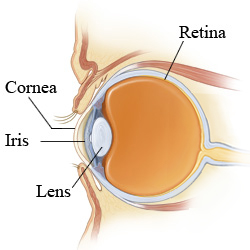
What is a vitreous hemorrhage?
A vitreous hemorrhage is bleeding into the thick fluid that fills the center of the eye. This fluid is called the vitreous gel. The gel is clear, so light passes through it to the retina. The retina is the nerve layer at the back of the eye that sends images to your brain.
Having blood in the vitreous gel can keep light from reaching your retina. This causes vision problems. If the bleeding is severe, it can cause vision loss.
What are the symptoms?
The symptoms of a vitreous hemorrhage start suddenly. They may include:
- Blurred vision.
- Floaters. These are black specks or strings that float across your field of vision.
- Flashes of light.
Symptoms may be worse in the morning. That's because lying down can cause the blood to pool in the back of your eye.
What causes a vitreous hemorrhage?
The most common cause is diabetic retinopathy, an eye disease caused by diabetes. In this disease, abnormal blood vessels may grow on the retina. These blood vessels break easily and may leak blood into the eye.
Other things that can cause a vitreous hemorrhage include:
- An eye or head injury.
- Damage to the retina, such as a hole in the retina (retinal tear).
- Bleeding in another part of the eye that seeps into the vitreous gel.
What can you expect when you have a vitreous hemorrhage?
An eye doctor (ophthalmologist) will do a complete eye exam to look for the cause of your symptoms. The doctor may use eyedrops to open (dilate) your pupils. You might also have other tests, such as blood tests or an ultrasound.
If the bleeding is mild, you may not need treatment. Your body will get rid of the blood over time. But this may take several months.
Your doctor may suggest that you sleep with the head of your bed raised about 45 degrees. The doctor may also want you to avoid aspirin and other blood-thinning medicines.
Treatment will depend on what's causing the bleeding and how severe it is. Some problems can be treated using a laser or a freezing probe (cryotherapy). Other problems may require surgery.
Current as of: October 1, 2025
Author: Ignite Healthwise, LLC Staff
Clinical Review Board
All Ignite Healthwise, LLC education is reviewed by a team that includes physicians, nurses, advanced practitioners, registered dieticians, and other healthcare professionals.

